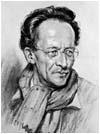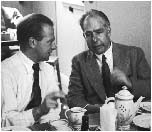
Erwin Schrödinger
 Erwin Schrödinger |
"Physical discoveries in the future are a matter of the sixth decimal place." –Albert Michaelson at
the dedication of the Ryerson Physical Laboratory
at the University of Chicago in 1894.
As the century unfolded, experiments began to show that the classical physics of Newton and Maxwell did not describe the emerging world inside the atom. From the work of Max Planck, Niels Bohr, Werner Heisenberg, Erwin Schrödinger and others came quantum mechanics, a new set of physical laws to describe the behavior of particles at the atomic scale.
Well, not exactly . . . In fact, the entire framework of physics was about to change.

Albert Einstein
Quantum mechanics and special relativity gave physicists a revolutionary new view of the fundamental nature of matter.
Quantum theory said:

Wemer Heisenberg and Niels Bohr
Classical physics also failed to describe space
and time at velocities close to the speed of light. Albert Einstein’s theory of
special relativity showed that space and time can change
in different reference frames. Special relativity described the behavior
of particles moving at high velocities and yielded the famous equation E = mc2, which says that mass and energy are the same.